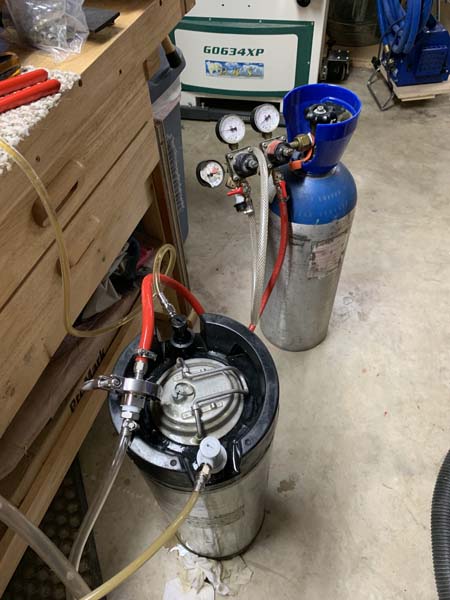Keg Carbonator Gizmo
I’ve have had little consistency with my attempts to carbonate my kegged beer recently. Looking in to how I might up my game, I came across the Blichmann Engineering keg carbonating system they named QuickCarb™. It looked like a pretty cool system and it occurred to me that I could build my own with parts I already had laying around and honestly, you’re likely better off purchasing the Blichmann product than fooling around making your own. It’s just that I had already purchased the SS Brewtech inline aeration kit for my fermentor and I wasn’t using it. I use a more primitive system comprised of a stone attached to the end of a stainless steel racking can and it works just fine. I realized that with “just a few more parts” I could build a carbonator thingy and pay homage to Blichmann’s genious.

After purchasing a few additional 1.5″ Tri-Clover with 1/4″ barb fittings, I hooked everything up for a test. CO2 is delivered to the stainless steel aeration stone and its flow can be controlled using the provided valve (blue handle above). I used a tiny of amount of CO2 pressure in the keg to push beer into the pump for priming. Once primed, I plugged the pump in and released the pressure in the keg. This allowed the pump to suck beer out, through the carb stone and returning via the gas in (grey connector) at the keg.

Here is a look at the carbonated beer being returned to keg. The system is allowed to cycle for around 40 minutes.

So what are my observations and conclusions about this experiment?
Issues
- Priming the pump
- adding a little pressure to keg allowed me to easily prime the little pump but disconnecting the gas in and reconnecting the beer return made pressure in the line back flush beer.
- I should be able to pressurize, disconnect, then reconnect the return but it seemed like when I did that everything got sucked back and the pump lost prime.
- Haven’t attempted a way to hold or mount this system yet.
- I was considering splitting a piece of PVC pipe to use as a mount for the Tri-Cover tee components.
- I suppose the principle is that once the pressure in your keg reaches your pressure set point on the regulator, the beer won’t continue to carbonate even as it continues to cycle.
- my conclusion after realizing that the return beer looked clear (IOW no longer carbonating) after pressure in the keg built up.
- releasing pressure in the keg caused the beer to look cloudy (IOW carbonating again)
- does this mean the beer has reached equilibrium with the desired pressure?
Conclusions
- Even my first feeble attempt was successful
- I plan to improve on the process
- This project was beneficial to me because I had already purchased expensive parts that weren’t being used
- Blichmann Engineering rocks. Buy their products!